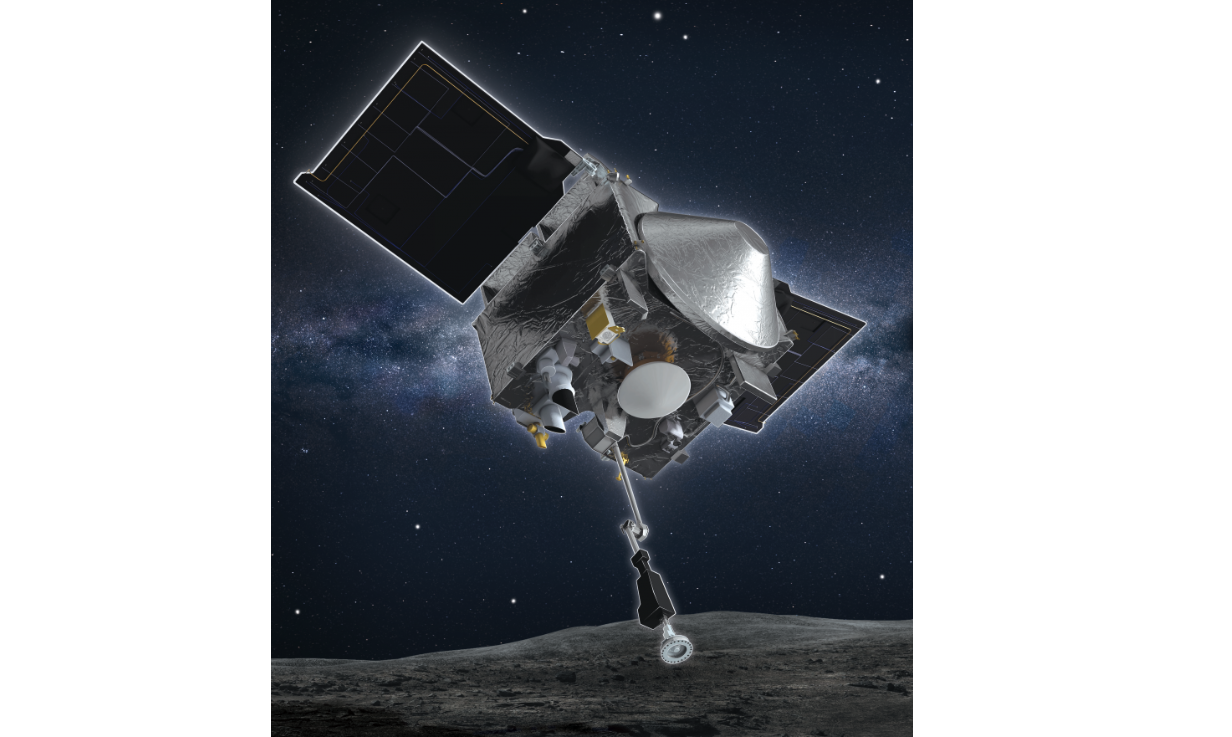
NASA’s Osiris-Rex asteroid sample return mission team has announced the selection of primary and backup collection sites on the surface of Bennu, a 1,600-ft.-wide primitive Solar System asteroid.
Bennu’s chemistry may hold secrets to the formation of the planets, including the distribution of water and organics, the building blocks of life.
The selections were made from four final candidate sites studied by the solar-powered spacecraft from low altitude. They were announced Dec. 12 at the fall meeting of the American Geophysical Union in San Francisco. They are:
- Nightingale, the primary, is a small crater within a larger, nearly 500-ft.-wide crater near Bennu’s north pole bearing fine-grained material deemed to have a high probably of containing water ice and organic content. But Nightingale is poorly lit in comparison to the other contenders and near a building-sized boulder on the eastern crater rim that could pose a hazard.
- Osprey, the backup, is located near Bennu’s equator in a 65-ft.-radius crater. Osprey was initially assessed because of the suspected presence of a highly desired, carbon-rich surface. There were early concerns Osprey might host soil material larger than the 3/4-in. (2-cm)-sized grains that Osiris-Rex was designed to collect.
More close-up surface reconnaissance of the two sites is planned beginning in January. Then Osiris-Rex will attempt as soon as July 4, 2020, to descend with an 11-ft.-long robot arm called the Touch and Go Sample Acquisition Mechanism (Tagsam) extended to briefly tap the surface. A burst of nitrogen gas from Tagsam is to stir up loose, fine-grained soil and rock into a sample container before the spacecraft rises.
The objective is to collect between 2 oz. and 4.4 lb. of material. Osiris-Rex is equipped with enough nitrogen for up to three sample collection attempts, though if the first is deemed a success, no more attempts are planned.
The $1 billion mission launched Sept. 8, 2016, reached Bennu on Dec. 3, 2018, and maneuvered into a preliminary orbit on Dec. 31. Under the current timeline, the spacecraft will depart Bennu, now more than 155 million mi. from Earth, in March 2021. Upon its return, Osiris-Rex is to release a 100-lb. sample return capsule as it races past the planet on Sept. 24, 2023. Four minutes after release, the return capsule will enter the Earth’s atmosphere for a parachute-assisted landing on the U.S. Army’s Utah Test and Training range for recovery.
Since reaching Bennu, Osiris-Rex has crossed and circled the asteroid from altitudes as low as 738 ft. to assess what was initially believed to be a sandy, beach-like environment. But the reconnaissance revealed a cratered, rock and boulder-strewn terrain that has ramped up the challenge of finding a low-risk sample site. This delayed a decision once envisioned for last August.
“When we got there, the most obvious feature that we saw were these abundant, very large boulders and an overall rough and rugged surface, very different than what we designed the spacecraft to sample,” said Dante Lauretta, the University of Arizona Osiris-Rex science team lead who announced the selections.
“We were looking at sampling areas that were 25 m (82 ft.) in radius across,” he explained. “Quite honestly, I thought it would be obvious from the first images where the sample regions were and that it would be a straightforward sample selection. It was nothing of the sort.”
Instead, the NASA Goddard Space Flight Center-led effort sorted through 50 sites. The candidates were narrowed first to 16, then eight, and finally four, all of which had to be weighed for science value against landing site hazards.
The other finalists were:
- Sandpiper, located in a large southern hemisphere crater with relatively flat terrain and just more than 200 ft. across. The target itself consists of fine-grained surface material, but is situated between potential large rock hazards.
- Kingfisher, located in a crater near the equator about 25 ft. across. Kingfisher is surrounded by boulders, but the touchdown target site has a 16-ft. radius and has been assessed free of large rocks.
To deal with the rock-strewn terrain, Osiris-Rex is equipped with thrusters and will be programmed with reconnaissance-enhanced software to autonomously ascend if the hazard avoidance navigation system detects a boulder threat as it descends for the sample collection.
Earlier this week, the Osiris-Rex mission team revealed one of the lengthy mission’s most challenging episodes: an Oct. 11 telecommunications outage at a Madrid ground station in NASA’s Deep Space Network, which is the two-way communications link for the agency’s planetary missions.
The outage occurred prior to an Osiris-Rex flyover of Osprey and threatened to delay the final site selection process. The team managed to compress a normal 24-hr. exchange with the spacecraft to 4 hr. in order to proceed with the flyover on Oct. 12 and successfully obtain the desired imagery.
Last month, the Japan Aerospace Exploration Agency’s (JAXA) Hayabusa 2 sample return mission to the larger asteroid Ryugu began its journey back to Earth after landing twice to gather surface and subsurface samples. In late 2020, the spacecraft is to release a sample container into remote Australia for recovery.
The NASA and JAXA mission teams plan to exchange some of the samples they return. Significant amounts will also be archived in the astromaterials laboratory at NASA’s Johnson Space Center so they can also be studied as new laboratory technologies emerge.





